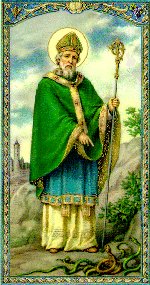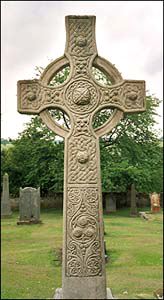![]()
Who was Saint Patrick?
 Saint Patrick  Celtic Cross | Saint Patrick is known as the patron saint of Ireland. Although he was not born Irish, he has become an important part of the Irish heritage, mostly through his service across Ireland in the 5th century. It is believed that Patrick was born in the late 4th century A.D., but there are differing views about the exact year and place of his birth. According to some historians, he was born about 390 A.D., but other historians say it was about 373 AD. Some historians believe that he was born in Scotland, and others believe it was Roman England. Many of the stories traditionally associated with St. Patrick, including the famous account of his banishing all the snakes from Ireland, are false. The stories are products of hundreds of years of exaggerated storytelling. His real name was probably Maewyn Succat, and Patricius was his Romanicized name. Later he became familiar as Patrick. It is known that St. Patrick was born in Britain to wealthy parents near the end of the fourth century. He is believed to have died on March 17, around 460 A.D. At the age of sixteen, Patrick was taken prisoner by a group of Irish raiders who were attacking his family's estate. They took him to Ireland where he spent six years being a slave. During his slavery, he worked as a shepherd outside and away from people. Lonely and afraid, he turned to his religion for comfort. He became a devout Christian. After more than six years as a prisoner, Patrick escaped. He wrote about hearing God's voice. This voice spoke to him in a dream, telling him it was time to leave Ireland. To do this, Patrick walked nearly 200 miles to the Irish coast. After escaping to Britain, Patrick wrote that he had a second dream where an angel told him to return to Ireland as a missionary. Soon after that dream, Patrick began his religious training. He studied more than fifteen years. He became a priest, and then later a bishop. Patrick was sent to Ireland with a double mission. He ministered to Christians already living in Ireland, and he began to convert the Irish to Christianity. Patrick was familiar with the Irish language and culture, because of his slavery there. Patrick didn't try to make the Irish forget their old beliefs. He decided to add traditional Irish rituals into his lessons of Christianity. For example, he used bonfires to celebrate Easter because the Irish always honored their gods with fire. He also added the sun, a powerful Irish symbol, onto the Christian cross to create what is now called a Celtic cross, so that the new symbol of Christianity would be more natural to the Irish. For these reasons, Patrick was very successful in converting the Irish to Christianity. Unfortunately, Patrick's success upset the Celtic Druids - the original religious leaders of the Irish. Patrick was arrested several times, but he escaped each time. Patrick's mission in Ireland lasted for thirty years. During his career, he traveled all over Ireland. He established monasteries across the country. He also set up schools and churches that helped him converting the Irish country to Christianity. When Patrick retired, he moved to County Down. He died on March 17 in AD 461. That day has been celebrated as St. Patrick's Day ever since. |